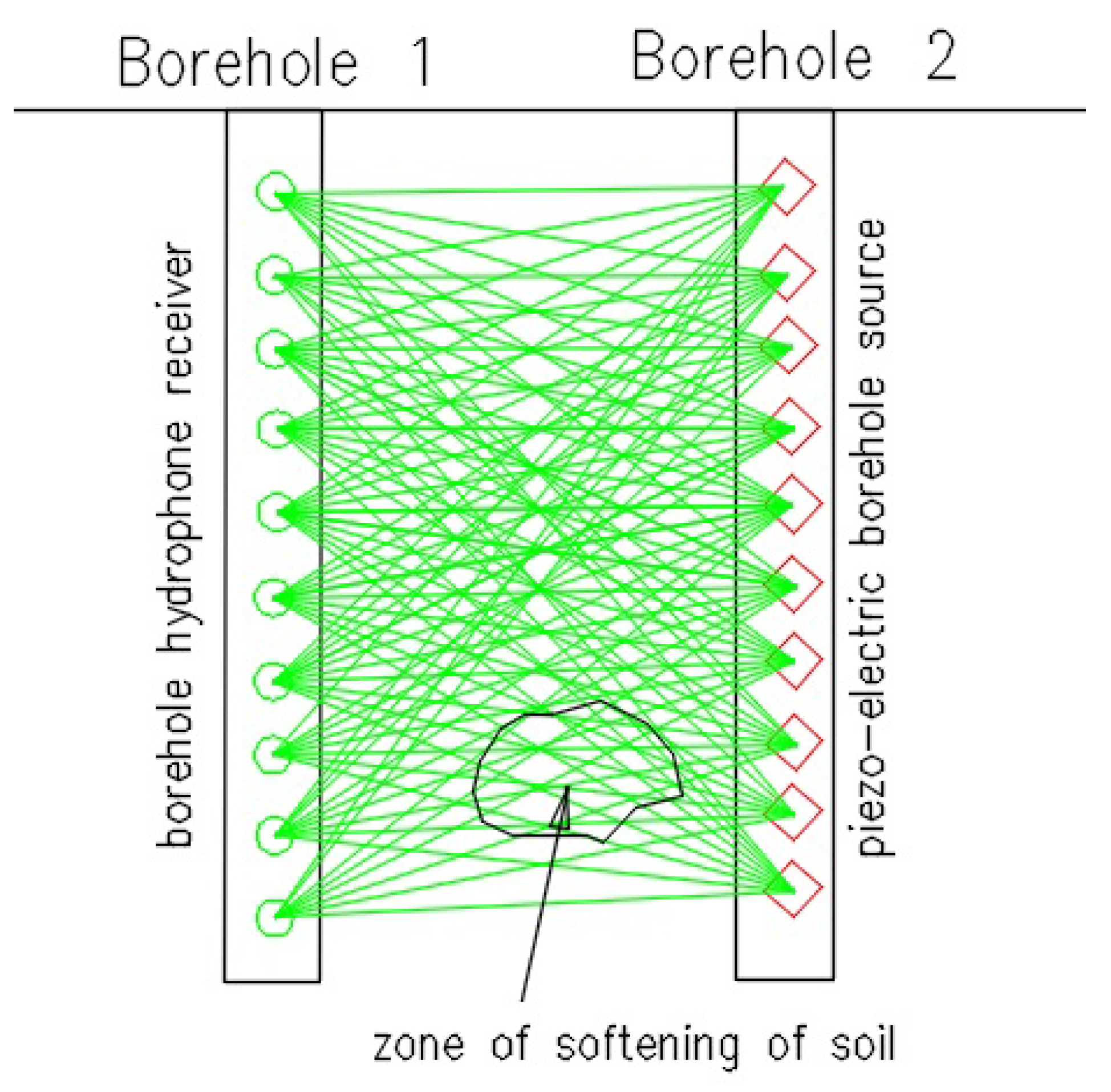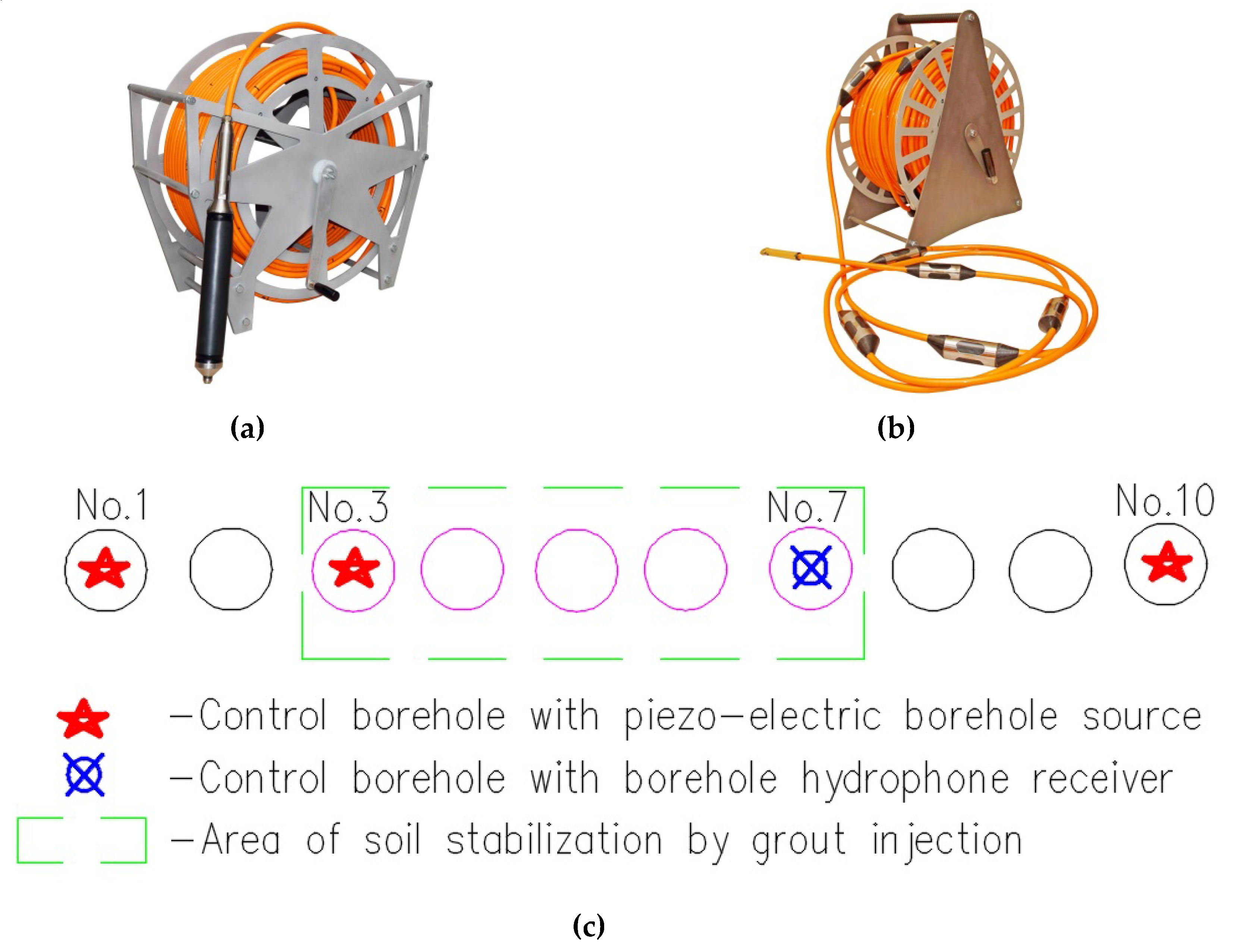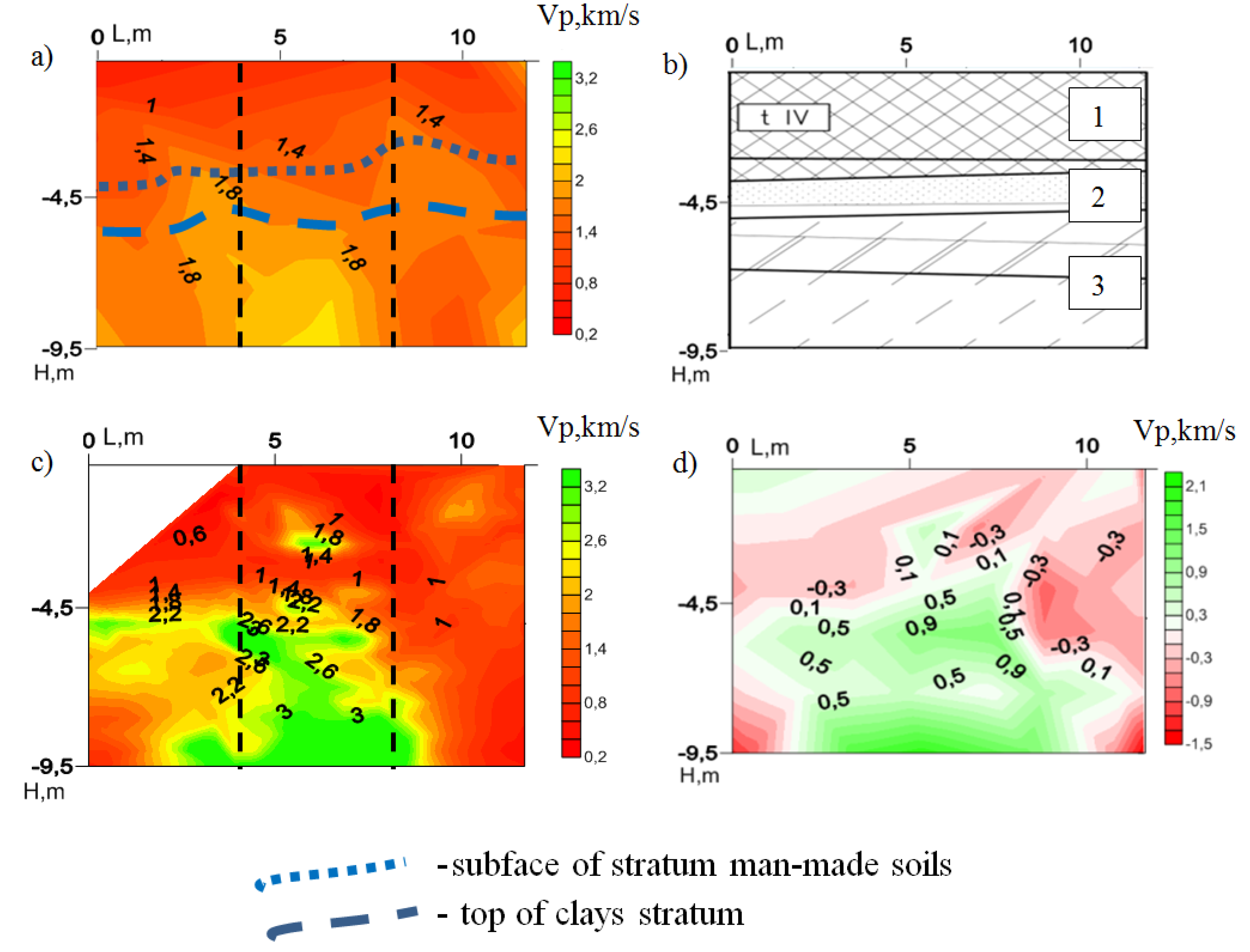Application of Cross-Hole Tomography for Assessment of Soil Stabilization by Grout Injection
Abstract
:1. Introduction
2. Survey Methods
- Receiver group interval (downhole disposition of hydrophones) of 1 m;
- Source point interval along borehole axis of 1 m;
- Interhole intervals of 3.8 m, 7.9 m, and 11.7 m;
- Quantity of active hydrophones at each position of a source of 10;
- Quantity of source positions along borehole axis of 10.
- A high-frequency seismic station (operating frequencies range: 1.75 Hz through 20 kHz);
- A relatively lightweight cable line with 12 interrelated seismic chains and hydrophone modules (with an operating frequency range of 10 through 10,000 Hz and an instrument sensitivity of 180 ± 30 µV/Pa) (Figure 2b);
- An electric spark source set comprising energy storage (power of 1200 J) and a high-voltage cable line with a fixed electric spark source at the end, a so-called sparker (Figure 2b).
- A spherical chart of orientation of the source and receiver;
- A high frequency of signal (hundreds of hertz, 1–2 KHz), which ensured a high resolution;
- A high shooting speed.
3. Results: Experiment on Cross-Hole Seismic Tomography for Assessment of Soil Stabilization by Grout Injection
- Drilling and preparation of injection boreholes located within a test site (Figure 3a), which were intended for passing an injected grout mixture. Boreholes No. 1, No. 3, No. 7, and No. 10 were used for cross-hole seismic tomography and an assessment of the real conditions of soil prior to the implementation of injective stabilization by way of interhole seismic tomography;
- Implementation of injective stabilization with a preliminarily prepared grout mixture being introduced into soil;
- Conduction of control observations by way of cross-hole seismic tomography for the evaluation of efficiency of the undertaken actions.
4. Discussion
- A beyond-design amount of grout mixture was injected into the bottom stratum (9.3–9.0 m) of the ground, entailing upheaval of the upper part of the profile;
- The injection upwards also caused “swelling” of the relatively weak upper part constituted of the man-made undisturbed ground;
- The appearance (effusion) of the slurry on the surface as detected during the injection (in the building basement, at mouths of adjacent boreholes) made stabilization of the entire mass up to the daylight surface unfeasible;
- Upon completion of the pumping, the injected slurry sublaterally spread throughout the soil, and the vertical component of the filled volume was reduced, which led to slight subsidence of the stabilized soil. The upper part also slightly subsided. The upheaval and subsidence of nonstabilized surface layers of soil led to decompaction accompanied by a reduction in strength, which resulted in the reduction of velocity-related features. The obtained data constitute the basis for issuing recommendations on the additional grouting of zones characterized by local discontinuities in boreholes No. 4, No. 5, and No. 6 (the depth range 6.5–7 m), a proposal for a more efficient injection procedure that assumes that the ground stabilization is performed without any losses in strength of the upper part of the soil profile;
- The implementation of the preventive stabilization of surface layers of the ground need for ensuring a kind of screen that could hamper both the injected slurry effusion and the upheaval of a weakened part of the surface;
- The injection amount should not significantly exceed the design-assumed values.
5. Conclusions
- A high-resolution capability of surveys;
- The ability to survey literally at any depth, even given constricted conditions within an urban area (depending just on the borehole depth).
Author Contributions
Funding
Conflicts of Interest
References
- Ulitsky, V.M.; Shashkin, A.G.; Shashkin, K.G. Geotechnical support of urban development. In The Practical Guide to Designing Buildings and Underground Structures under Restrained urban Conditions; Group of Companies Georekonstruktsiya: St. Petersburg, Russia, 2010. [Google Scholar]
- Petrukhin, V.P. Geotechnical problems of construction in Moscow-the largest metropolis of Russia. In Geotechnical problems of megacities; Group of Companies Georekonstruktsiya: St. Petersburg, Russia, 2010. [Google Scholar]
- Bezrodny, K.; Lebedev, M.; Larionov, R. Preservation of urban historic centers. I Conference ACUUS 2016, St. Petersburg, Russia, 12–15 September 2016. [Google Scholar]
- Mangushev, R.A.; Osokin, A.I. Geotechnics of Saint Petersburg; Publishing House ASB: Moscow, Russia, 2010. [Google Scholar]
- Il’ichev, V.A.; Nikiforova, N.W.; Gotman, J.A.; Puffins, M.M.; Trofimov, E.Y. Analysis of passive and active methods of protection of existing buildings during underground construction. The Zhilishnoe Stroitel’stvo (Hous. Constr.) 2003, 12, 25–28. [Google Scholar]
- Bezrodny, K.P.; Salan, I.A.; Maslak, V.A.; Lebedev, M.O.; Starkov, A.Y.; Morozov, A.V. The Implementation of Bezusadochnye Technologies in the Construction of the St. Petersburg Metro; Transport of the Russian Federation: Moscow, Russia, 2010. [Google Scholar]
- Maslak, V.A.; Bezrodny, K.P.; Lebedev, M.O.; Markov, V.A.; Zakharov, G.R.; Ledyaev, A.P.; Stark, A.Y. Low-technology in the construction of the subway in the historic centre of St. Petersburg. Metro and Tunn. 2013, 12, 28–32. [Google Scholar]
- Maslak, V.A.; Bezrodny, K.P.; Lebedev, M.O.; Gendler, S.G. New technical and technological solutions for the construction of underground tunnels in a metropolis. Min. J. 2014, 12, 57–60. [Google Scholar]
- Bezrodny, K.P.; Lebedev, M.O.; Markov, V.A.; Starkov, A.Y. Geotechnical support in the construction of a double-track distillation tunnel with the help of tpmk. Subway Tunn. 2015, 12, 16–19. [Google Scholar]
- Bezrodny, K.P.; Matsegora, A.G.; Lebedev, M.O. Technology of construction of metro stations in dense urban areas. In Proceedings of the International Conference on Geotechnics urban Development and Geotechnical Construction, St. Petersburg, Russia, 16–19 June 2008; pp. 555–561. [Google Scholar]
- Bezrodny, K.P.; Matsegora, A.G.; Maslak, V.A.; Osokin, A.I.; Jaltintsev, V.B.; Elagin, V.N. Control injection fortifications in ground conditions of St. Petersburg. The Zhilishnoe Stroitel’stvo (Hous. Constr.) 2009, 12, 4–9. [Google Scholar]
- Lisin, V.P. Possibilities of inspection and monitoring of the ground bases of port terminals by shallow geophysical methods. In Journal Engineering survey 10–11/2015; Geomarketing: Moscow, Russia, 2015; pp. 86–95. [Google Scholar]
- Ertsalov, M.G.; Simutin, A.N.; Alexandrov, A.V. Technology of compensation injection for protection of buildings and structures. MGSU//Bulletin 2015, 6, 32–40. [Google Scholar]
- Meyr, R.; Khayt, D. Tekhnologiya kompensiruyushchego inetsirovaniya rastvorov v grunt, Digest of Foreign Information. Inf. Izdat. Cent. TIMR 1995, 2, 43–45. [Google Scholar]
- Schweiger, H.F.; Falk, E. Reduction of Settlements by Compensation Grouting, Numerical Studies and Experience From Lisbon Underground. In Proceedings of the World Tunnel Congress, Sao Paolo, Russia; 1998; pp. 1047–1052. [Google Scholar]
- Valet, J.L. Kompensationoe nagnetanie: Tekhnologiya v real’nom vremeni. Metro i tonneli 2002, 4, 16–19. [Google Scholar]
- Ibragimov, M.N.; Semkin, V.V.; Shaposhnikov, A.V. Some problems of grouting solutions from microcemento. Build. Sci. 2016, 4, 114–120. [Google Scholar]
- Korolev, V.M.; Smirnov, O.E.; Argal, E.S.; Ashikhmin, V.A. Experience of soil consolidation with the help of microcement. Bases, Found. Soil Mech. 2006, 4, 10–14. [Google Scholar]
- Ibragimov, M.N. Questions of design and production of works of compaction of soil by injection of solutions on hydraulic fracturing technology. Bases, Found. Soil Mech. 2015, 2, 22–27. [Google Scholar]
- Voznesenskaya, E.S.; Ermolaev, V.A.; Osokin, A.I.; Tatarinov, S.N. Strengthening of the bases of buildings and constructions by a method of hydraulic fracturing with use of cuff technology. Bases, Found. Soil Mech. 2014, 6, 19–24. [Google Scholar]
- Ogilvy, A.A. Fundamentals of engineering Geophysics; Bogoslovsky, V.A., Ed.; Nedra: Moscow, Russia, 1990. [Google Scholar]
- Bolgarov, A.G.; Roslov, Y.V. Inter-Well seismic tomography for solving engineering-geological problems. Seism. Explor. Technol. 2009, 1, 105–111. [Google Scholar]
- Shishkina, M.A.; Fokin, I.V.; Tikhotskii, S.A. Razreshayushchaya sposobnost’ mezhskvazhinnoj luchevoj sejsmicheskoj tomografii: rasstanovka, skorostnaya model’, konechnaya chastota signala. Information portal of the Institute of IPZ RAS. Available online: http://www.ifz.ru/lab-202/inverse-problems/tomo-resolution/ (accessed on 12 September 2019).
- Shishkina, M.A.; Fokin, I.V.; Tikhotsky, S.A. On the problem of resolution of inter-well radiation tomography. Seism. Explor. Technol. 2015, 1, 5–21. [Google Scholar]
- Dorokhin, K.A.; Boyko, O.V. Seismoacoustic monitoring to assess the quality of the execution of protective structures and compensatory strengthening of the soil rock. In Proceedings of the 14th Conference and Exhibition on Engineering and Mining Geophysics, Almaty, Kazakhstan, 23–27 April 2018; pp. 56–70. [Google Scholar]
- Dobróka, M.; Szegedi, H. On the generalization of seismic tomography algorithms. Am. J. Comput. Math. 2014, 4, 37–46. [Google Scholar]
- Kubota, K.; Kiho, K.; Mizohata, S.; Murakami, F. Development of directional drilling system and measurement method in the borehole application of seismic tomography between surface and the borehole. In Proceedings of the 10th IAEG Asian Regional Conference 2015, Kyoto, Japan, 26–29 September 2015. [Google Scholar]
- Li, Y.; Hewett, B. Borehole seismic quantitative diagnosis of a seismic velocity model for 3D seismic imaging of subsurface structures. Geophys. Prospecting 2014, 62, 719–739. [Google Scholar] [CrossRef]
- von Ketelhodt, J.K.; Fechner, T.; Manzi, M.S.; Durrheim, R.J. Joint inversion of cross-borehole P-waves, horizontally and vertically polarized S-waves: tomographic data for hydro-geophysical site characterization. Near Surf. Geophys. 2018, 16, 529–542. [Google Scholar] [CrossRef]
- Angioni, T.; Rechtien, R.D.; Cardimona, S.J.; Luna, R. Crosshole seismic tomography and borehole logging for engineering site characterization in Sikeston, MO, USA. Tectonophysics 2003, 368, 119–137. [Google Scholar] [CrossRef]
- Carrion, P.; Costa, J.; Pinheiro, J.E.; Schoenberg, M. Crossborehole tomography in anisotropic media. Geophysics 1992, 57, 1194–1198. [Google Scholar] [CrossRef]
- Dietrich, P.; Tronicke, J. Integrated analysis and interpretation of cross-hole P- and S-wave tomograms: A case study. Near Surf. Geophys. 2009, 7, 101–109. [Google Scholar] [CrossRef]




© 2019 by the authors. Licensee MDPI, Basel, Switzerland. This article is an open access article distributed under the terms and conditions of the Creative Commons Attribution (CC BY) license (http://creativecommons.org/licenses/by/4.0/).
Share and Cite
Lebedev, M.; Dorokhin, K. Application of Cross-Hole Tomography for Assessment of Soil Stabilization by Grout Injection. Geosciences 2019, 9, 399. https://doi.org/10.3390/geosciences9090399
Lebedev M, Dorokhin K. Application of Cross-Hole Tomography for Assessment of Soil Stabilization by Grout Injection. Geosciences. 2019; 9(9):399. https://doi.org/10.3390/geosciences9090399
Chicago/Turabian StyleLebedev, Mikhail, and Kirill Dorokhin. 2019. "Application of Cross-Hole Tomography for Assessment of Soil Stabilization by Grout Injection" Geosciences 9, no. 9: 399. https://doi.org/10.3390/geosciences9090399
APA StyleLebedev, M., & Dorokhin, K. (2019). Application of Cross-Hole Tomography for Assessment of Soil Stabilization by Grout Injection. Geosciences, 9(9), 399. https://doi.org/10.3390/geosciences9090399



